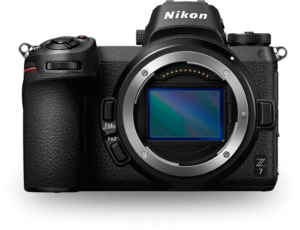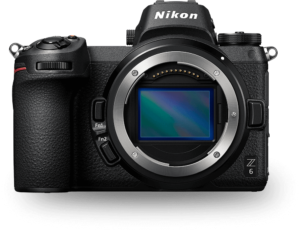Most photographers make most of their images using a zoom lens. Aside from smartphone cameras, which typically feature a fixed focal-length lens, nearly every camera today comes with a zoom lens attached. Most point-and-shoot and compact cameras do not have interchangeable lenses, so the zoom lens that comes with the camera is the only choice, while most mirrorless and DSLR cameras have interchangeable lenses. That means these more advanced cameras offer the choice of using a broad range of different lenses, including both zoom and prime (fixed focal-length) lenses. While many photographers own one or several prime lenses, from my observation the vast majority shoot nearly all of their images using one of their zoom lenses instead. In today’s post, I make the case for using prime lenses in many, or even most, shooting situations.
 This portrait of a Delhi girl outside India’s largest mosque is lovely and effective, but because I didn’t have time to change lenses and was forced to use my slower walkaround zoom lens, the depth-of-field is quite deep, making for a somewhat distracting background. Buy this photo
This portrait of a Delhi girl outside India’s largest mosque is lovely and effective, but because I didn’t have time to change lenses and was forced to use my slower walkaround zoom lens, the depth-of-field is quite deep, making for a somewhat distracting background. Buy this photo
Zoom lenses have one clear advantage over prime lenses: they offer a range of focal lengths, which helps the photographer compose the image without having to walk closer to or farther away from the subject. But even here I would argue that in most cases it aids creativity to “zoom with the feet,” or walk around to compose the best shot. Even when this isn’t possible, a high-resolution digital image can easily be cropped in post-processing to achieve the composition the photographer had in mind.
But prime lenses have many advantages over zoom lenses. First, they are nearly always sharper and generally higher quality than zooms, because they don’t require extra internal glass elements to enable the zooming. While zoom lenses have improved in optical quality over recent years, it remains the case that prime lenses offer a quality advantage. Second, prime lenses are typically smaller and lighter than zooms. This is a blessing especially to travel photographers. Third, primes are less expensive than zooms of similar optical and build quality. That means you can buy two or three different prime lenses for the price of one zoom lens covering a similar range of focal lengths. And fourth, primes are usually faster (i.e., offer a wider maximum aperture size) than zooms. This last point is a big advantage for many types of shooting, because a wide aperture (small F-number) lets in more light, allowing use of faster shutter speeds and lower ISO settings in low-light conditions. This is a real boon for nighttime and astro-photography. A wide aperture also results in shallow depth-of-field, which emphasizes the main subject by softening the focus of the background. The best lenses offer a pleasing “bokeh”, or pleasant blurring of the out-of-focus elements of the image. This effect makes for extremely effective portraits as well as wildlife images, but is also useful for other types of photography.
 This portrait, made with my current favorite lens, an 85mm f/1.8 portrait lens, offers very sharp focus on the subject’s face and pleasing bokeh, or soft blurring of the out-of-focus background. It would not have been possible to make this portrait using a zoom lens because the maximum aperture would be too small to achieve the soft background effect. Buy this photo
This portrait, made with my current favorite lens, an 85mm f/1.8 portrait lens, offers very sharp focus on the subject’s face and pleasing bokeh, or soft blurring of the out-of-focus background. It would not have been possible to make this portrait using a zoom lens because the maximum aperture would be too small to achieve the soft background effect. Buy this photo
I shoot a lot of performing arts events (dance, music, theater), which typically take place indoors where the light is very dim and frequently feature fast-moving action requiring a fast shutter speed. Using a prime lens allows me to shoot at an action-freezing shutter speed without having to use extremely high ISO settings that introduce noise into the images. And again, the pleasantly blurred backgrounds help set off the very sharp main subject for a striking overall effect.
 I captured this image of a samba dancer at a dress rehearsal under very low-light conditions. Using my 85mm f/1.8 prime portrait lens, I was able to freeze the motion using a fast shutter speed, keep the ISO at a reasonable level to avoid noise, and render a nice soft background. Buy this photo
I captured this image of a samba dancer at a dress rehearsal under very low-light conditions. Using my 85mm f/1.8 prime portrait lens, I was able to freeze the motion using a fast shutter speed, keep the ISO at a reasonable level to avoid noise, and render a nice soft background. Buy this photo
I would estimate that most enthusiast and professional photographers shoot about 80% of their images using zoom lenses. My own usage pattern is the opposite, that is, I shoot about 80% of my images using prime lenses. For some purposes, a zoom lens is still required, but it’s surprising how often we can achieve better results using a prime. Prime lenses are smaller, lighter, less expensive, higher quality, and faster than zoom lenses. I encourage you to dig out your prime lenses if you have a few, or borrow, rent, or buy one or two (remember, they are much less expensive than comparable zoom lenses) and try shooting with them exclusively, or at least much of the time, for a week or two. Compare your images made with the primes vs. the ones made with zooms and come to your own conclusions. If you’re like me, you’ll find that a prime lens is the right tool for most photographic jobs.
Here are my three favorite prime lenses, a “normal” lens, a medium telephoto or “portrait” lens, and a wide-angle lens:
If you pack only one prime lens, it most likely will be a “normal” lens, that is one with a focal length of about 50mm for a full-frame camera or about 35mm for a crop-sensor camera. I carry the Nikon 50mm f/1.4G lens. This is the one I use in very low-light situations or to get a really shallow depth-of-field.
I think my current favorite lens of all (including primes and zooms) is my Nikon 85mm f/1.8G lens. This is a classic portrait lens and provides a flattering perspective and great image quality when your subject is a human being. I use it for nearly all of my portrait work these days. But this lens also shines for nature and action photography where you don’t need a really long focal length. It renders really lovely “bokeh”, or the soft quality of the out-of-focus parts of the image.
A wide-angle prime lens can be useful for landscapes, architecture and interiors, and astro-photography, among other purposes. I like the Nikon 24mm f/1.8.
What are your preferences regarding use of prime vs. zoom lenses, and why? Please share your experiences in the comments box.
Want to read other posts about gear? Find them all here: Posts on Gear.



